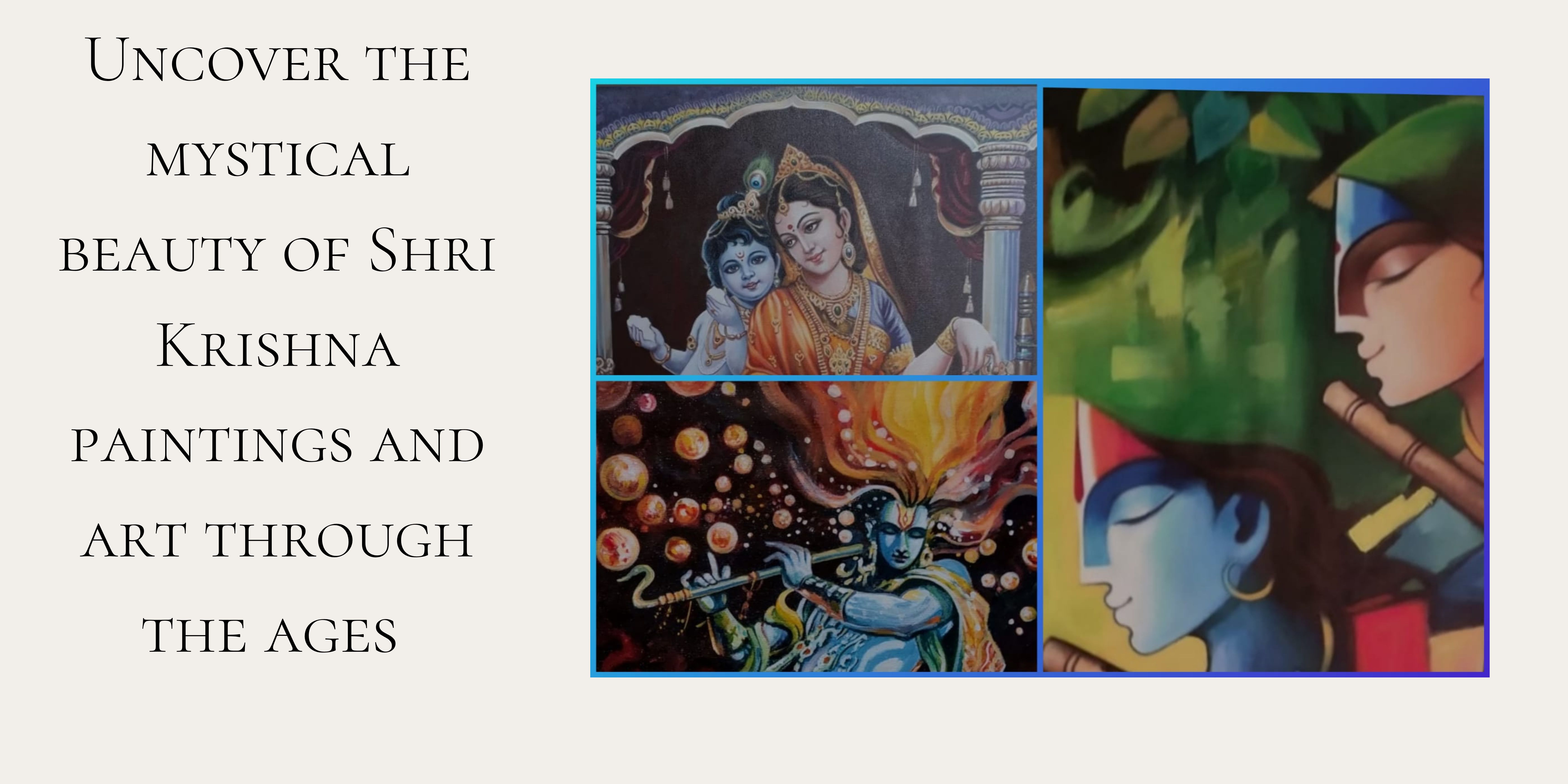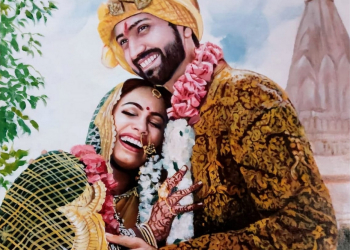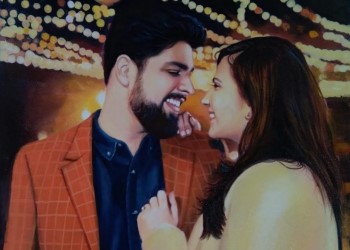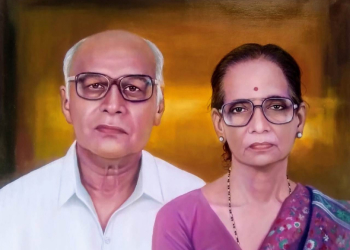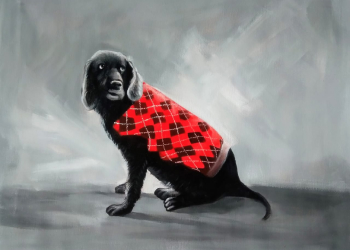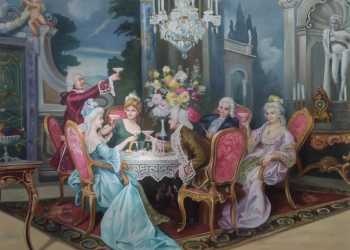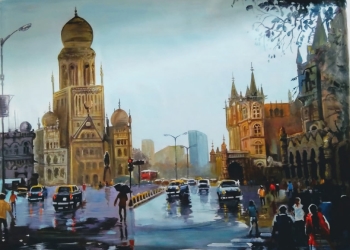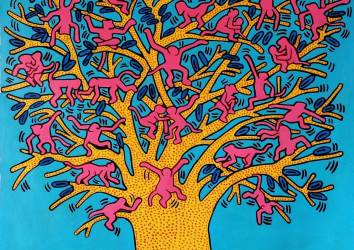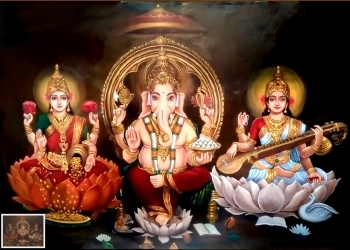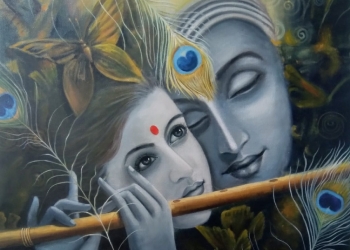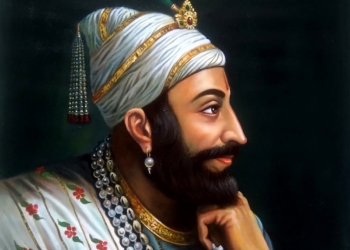Introduction:
The life of Krishna and his teachings have had a profound influence on Indian civilization and its people. Not only, is Krishna popular with all people, but his teachings are also highly regarded by the saints, poets, and artists. His presence can be seen in every aspect of Indian life, from religion to philosophy to art and painting. One can probably find Krishna images and Krishna paintings adorned in every other household in India.
A widely worshipped deity, Krishna is an important figure in Hinduism. In the epic Mahabharata, he is a powerful ally of the Pandavas, helping them to defeat their enemies. Bhagavad Gita, presents him as an avatar of Vishnu, teaching Arjuna the path of Dharma and knowledge. He also appears in numerous stories and folk tales, where he is often portrayed as a mischievous child with a fondness for cows and butter, a recurring theme in Krishna paintings. His life story portrays him as an ordinary man who exhibits extraordinary qualities, of strength and wisdom. He is also seen as a divine figure who shows compassion and mercy to those who seek his help. Through his actions and teachings, Krishna has become an important symbol of spiritual enlightenment for Hindus all over the world. Because of the centrality of Krishna in the Indian civilization, mythology, and the spiritual life of Indians, it comes as no surprise that Krishna is represented in art and paintings from ancient times.
Order Your Portrait Painting from Photo today!
The Harivamsha (probably added to the earlier Mahabharata around 450 AD ) fills in the background of Krishna, displaying his Godhood. Other texts such as The Vishnu Purana further describe Krishna's divinity, as well as a part of an eternal trinity with Brahma and Shiva. The description in epic literature and other texts provides the basis for the development of all Krishna paintings practiced by various groups and folk artists since ancient time times.
The Bhagavata Purana (also known as the Shrimad Bhagavatam) is the most important of the eighteen major Puranas and is devoted entirely to Krishna. The Bhagavata Purana is an invaluable source of information about the life and times of Krishna, as well as a powerful religious text for Hindus. While simultaneously providing artists with invaluable information on which to base their artwork and Krishna paintings.
This post examines the portrayal of Shri Krishna through the ages through Krishna paintings. You will see how artists have depicted, recreated, and reinterpreted Krishna through the ages in this post. The Krishna paintings are arranged in the chronological order of their creation from the ancient period dating back to the 2nd century BCE to the contemporary period, depicting various aspects of the life of Krishna (Krsna).
Krishna art from the Classical Era:
Several artworks and a few rock paintings of Krishna have survived from the classical era. Two of them are discussed below.
Rock painting of Krishna at Tikla
The oldest painting of the Shri Krishna is depicted as a triad found in rock paintings at Tikla, about 70 kilometers south of Gwalior in the district of Shivpuri. Based on a short Brahmi inscription written above the figural depictions on the rock surface, this rock painting can be dated between the late 3rd and early 2nd centuries BCE.
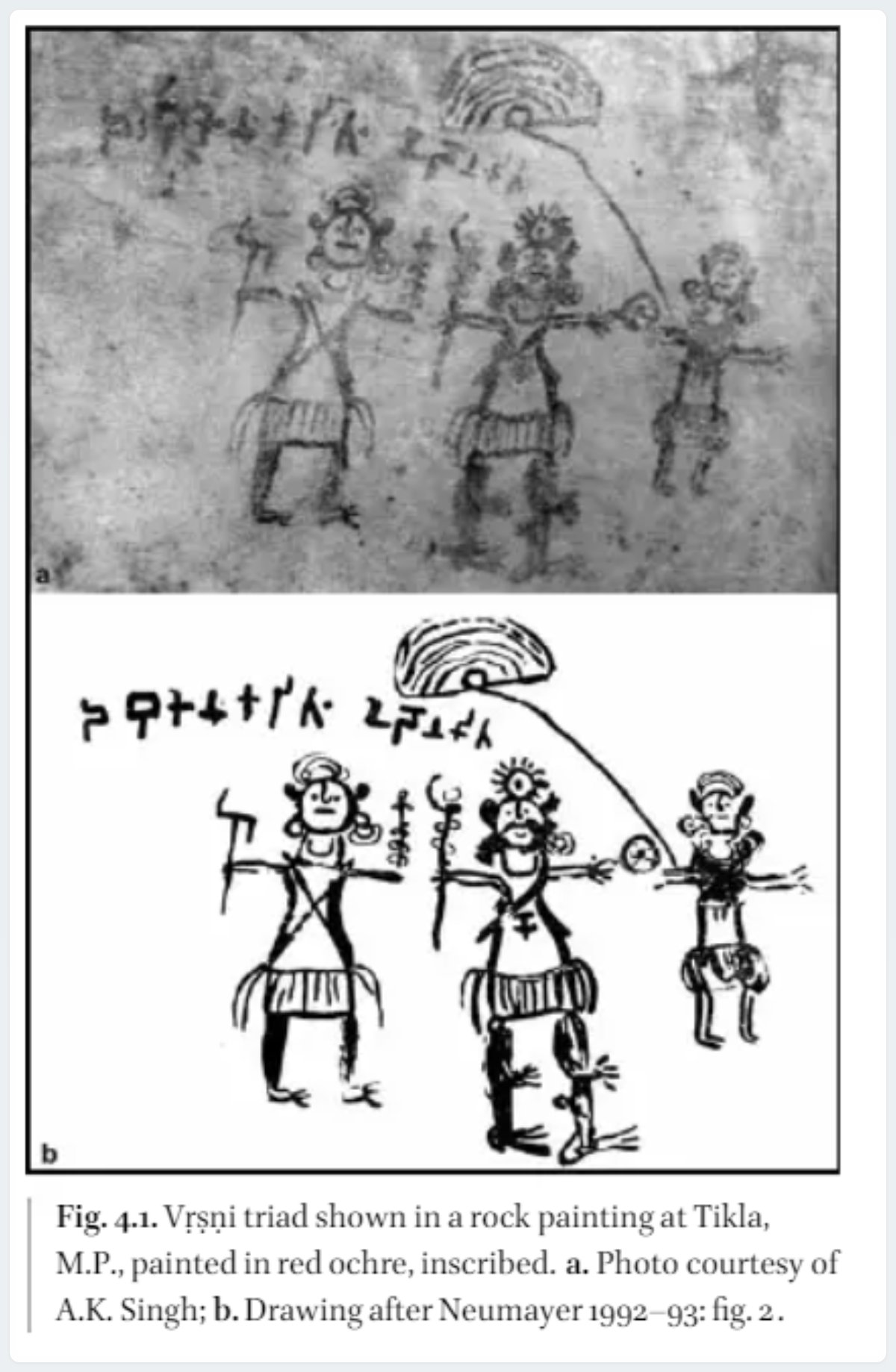 Krishna Rock painting Visni Triad (Image Credits: AK Singh)
Krishna Rock painting Visni Triad (Image Credits: AK Singh)
The painting depicts three human figures. The first figure from the left is a male holding a halayudha (Plough-weaponed, an epithet of Balarama who wielded a plow as his weapon) in his right hand. In his left hand, he is holding what appears to be a barbed harpoon with a snake hood on top. He is wearing a prominent headgear with two circular loops. His outfit was inspired by the tribal/rock art of the time. This figure should be identified as a representation of Balarama.
The second male, shown in the center and purposefully made slightly taller than the others, should be identified as Vasudeva Krishna. His left-hand stretches out and likely hold a disc or a flower, while his right hand holds an object similar to the first male's left hand, but with a longer handle. The most notable aspect of this figure is the headgear, depicted with what appears to be a solar disc.
The third figure appears to be holding a tall object, possibly a parasol, in her right hand. This figure should be identified as Ekanamsha. This goddess is the sister of Krishna (Kṛṣṇa) and Balarāma. She came to be known as Ekānaṃśā because she was born of one part (aṃśa) of Viṣhṇu himself.
The dresses of the three figures differ slightly, and it appears that the third figure is wearing a skirt and a blouse-like garment. The most notable feature of this triad is that it is the only known example of its kind following the proper genealogical hierarchy of the three deities as per Harivaṃśa Purāṇa.
Order Your Custom Handmade Oil Portrait Painting from Photo today
The Panel from Kondamotu
The State Museum in Hyderabad now houses an important sculptural panel discovered at Kondamotu in the Guntur District of Andhra Pradesh.
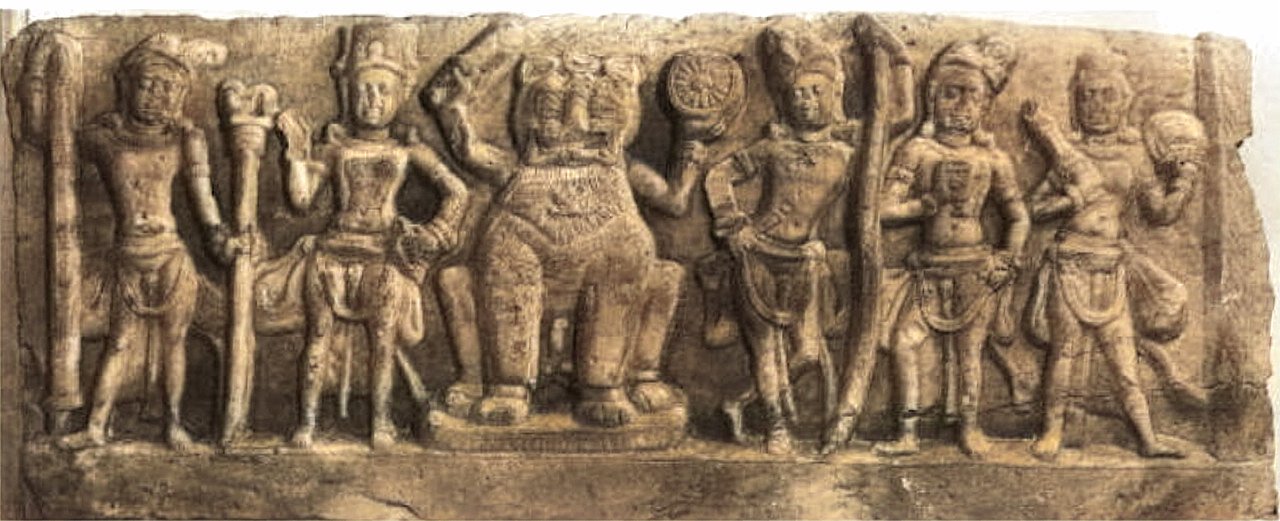 Sculptural relief panel from Kondamotu, AP State Museum Hyderabad ( Image Credits: American Institue of Indian Studies)
Sculptural relief panel from Kondamotu, AP State Museum Hyderabad ( Image Credits: American Institue of Indian Studies)
All five Vrsni Vras are carved in their proper genealogical order in this panel.
Samkarsana is carved from left to right, holding a mace in his right hand and a plowshare topped by a lion face in the left. Vasudeva Krishna stands next to him, his right hand in Abhaya mudra and his left hand holding a conch shell placed on his hip. The next figure depicts Narasimha, implying a merger of the Satvata and Panca Vrsni Vira sects. Pradyumna is depicted in the following figure, holding a bow in his left hand and an arrow in his right. To his left is the figure of Samba, who is holding a wine goblet in his right hand and resting his left hand on his waist. Aniruddha is the final figure, holding a sword in his right hand and a shield in his left. This sculpture dates to the late third/early fourth century CE and confirms the popularity of the Satvata-Panca Vrsni Vra sect in Andhra Pradesh at the time.
Krishna paintings during the Middle Ages
The following Krishna paintings are from the Middle ages. The Krishna Paintings from that period reflect the Persian influence on Indian art, which can be explained by the Islamic invasion, conquest, and disruption in India during that time. The techniques employed for making the paintings were usually colors derived from pigments from natural sources.
Krishna Tied to the Mortar, Damodara, from a Bhagavata Purana series
In Krishna's childhood, an important event underscoring Krishna's divinity. The Sanskrit Bhagavata Purana tells the story of the release of two yakshas, Nalakubera and Manigriva, sons of Kubera, transformed into two Arjuna trees. As Krishna crawled on the ground, he dragged the mortar between the intertwined trees. This pulled them down and released the two yakshas. The vernacular text above relates to the end of the previous chapter which described Yashoda's discovery of Krishna stealing butter. To keep him from his antics she tied him to the mortar. We see him poised to perform his miracle.
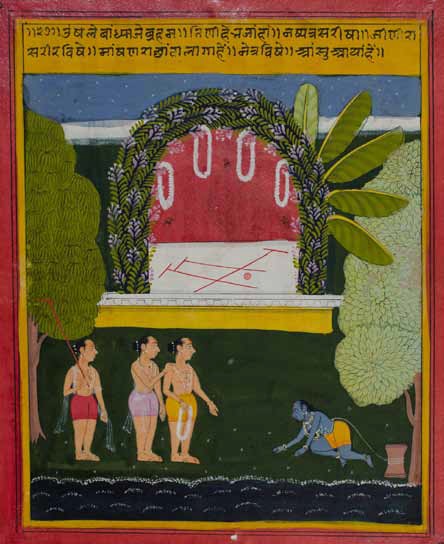 Krishna tied to mortar, Damodar (Image credits: Bhagavata Purana Series)
Krishna tied to mortar, Damodar (Image credits: Bhagavata Purana Series)
Theme: Krishna Painting
Title: Krishna Tied to the Mortar, Damodara, from a Bhagavata Purana series
Date Created: 1690
Place Created: Mewar Rajasthan
Physical Dimensions: 10 inches x 8.07 inches ( 25.5 cm x 20.5 cm)
Medium: On paper, Ink, opaque watercolor, and gold
Krishna Fluting, Venugopala
In Krishna's paintings, he is frequently depicted as Venugopala, the cow protector(Gopala), playing his flute (the venu). Krishna's mannered physiognomy is very tall here, as are the male figures to his left. The horizontal bands of land, vegetation, and river that surround the main figure suggest receding into space. He stands on an elaborate base topped by a lotus form. Actual jewels and pearls adorn Krishna's throne and figure, and the four attendants wear pearls, creating an opulent effect. The overall palette is quite varied, with intricate colored floral designs at the ends of his sashes and his main garment, a bright vermillion adorned with a gold pattern.
Krishna wears a kirtimukuta or crown. The male attendants carry camaras or yak-tail fly-whisks, a symbol of Krishna's divinity, even though the gopis and gopas were unaware of his divine nature. The figures' mannered style is difficult to place, but a similar painting is present in an album in the Bodleian Library accompanied only by male devotees and a cow. Another nine paintings from the same group are included in the album, indicating that this highly mannered style is from Datia in Central India.
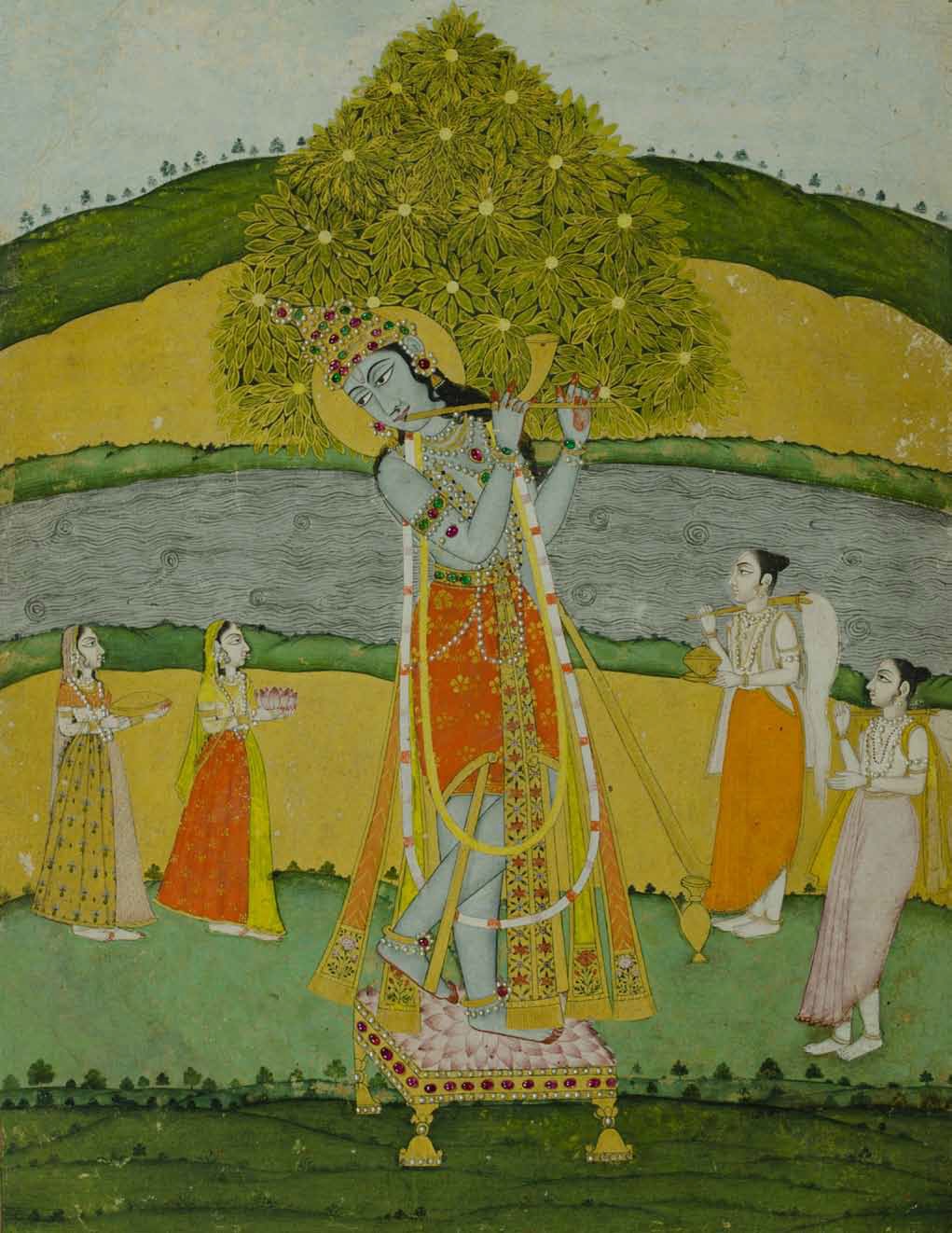 Krishna fluting Venugopala
Krishna fluting Venugopala
Theme: Krishna Painting
Title: Krishna Fluting, Venugopala
Date Created: 1760
Place: Datia, Central India, Madhya Pradesh
Physical Dimensions: 11.73 inches x 8.85 inches (29.8 cm x 22.5 cm)
Medium: On paper, ink, opaque watercolor, gold, pearls, and semiprecious stones
Handmade Art Reproductions & Landscape Paintings
Radha and Krishna
In 1591, Keshava Das (1580-1601) composed his well-known Rasikapriya. It is a collection of poems that describe and catalog various types of male and female lovers, Nayakas and Nayikas — heroes and heroines. Sets of paintings illustrating verses from this text can be found in many art centers, and a number of them are known.
In the Radha Krishna painting, Radha, the Nayika, first confides in her friend and confidant about her absent lover before lying on the couch in despair and longing. She reunites with her lover, the crowned Krishna, at the bottom. Radha appears three times, implying a continuous story. This is a common story-telling technique in Indian art. The painting's architecture is lavish and elegant; rooms are decorated with floral forms, adding a striking decorative element to the work. The colors used are bright and vivid - reds, yellows, and greens blend to create a sensation of intense emotion. The overall effect is one of beauty and joy - even though Radha's longing for her beloved was initially unrequited.
Following is the translation of the verse which appears above the painting:
The cow maids of yesterday manage the excitement that has erupted in your hearts today. She wastes her time thinking useless thoughts, brooding, and chanting the name of the beloved. Know that in your absence, Kanha [Krishna], whom you consider naughty, awaits your gaze just as you await his.
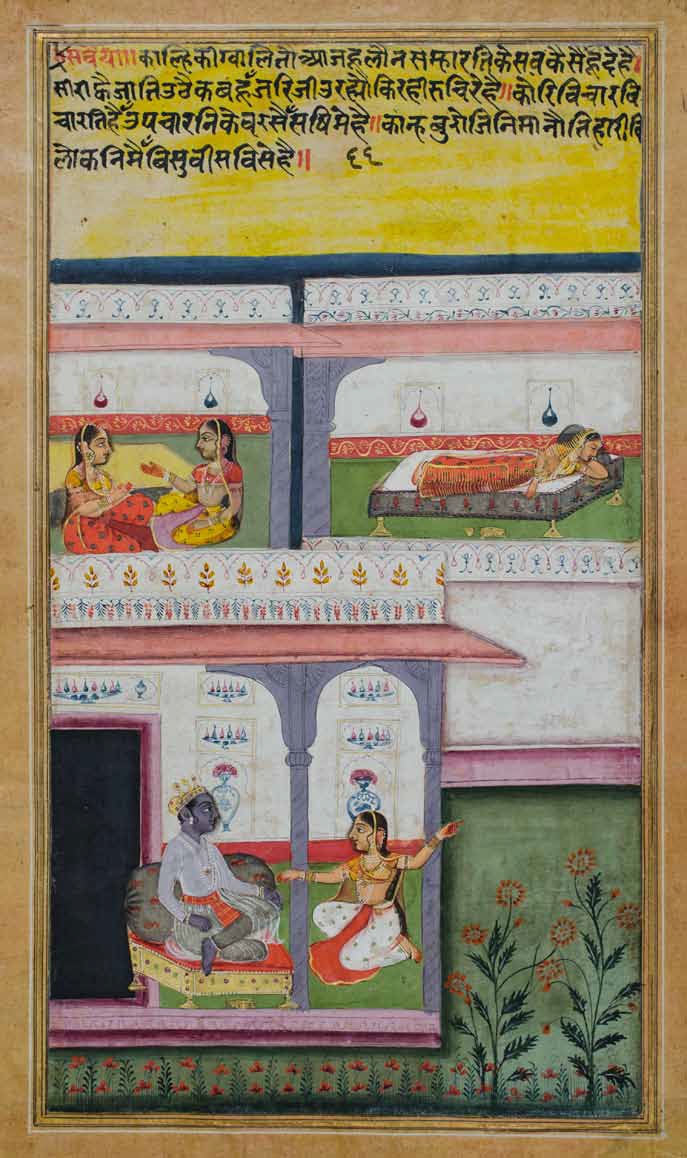 Radha Krishna From a Rasikapriya of Keshava Das series
Radha Krishna From a Rasikapriya of Keshava Das series
Theme: Krishna Painting
Title: Radha and Krishna, from a Rasikapriya of Keshava Das series
Date: created: 1680-1700
Place: Amber, Rajasthan
Physical Dimension:11.02 inches x 6.29 inches (28 x 16 cm)
Medium: On paper, Ink, opaque watercolor, and gold
Krishna Holds Up Mount Govardhan to Shelter the Villagers of Braj
In the Krishna painting, he is holding up Mount Govardhan to protect the villagers of Braj from destructive rains sent by the god Indra.
As the legend goes in the Bhagavata Purana, Krishna once reasoned with villagers Braj, to stop worshiping Indra (Rain God) and start worshiping Mount Govardhan which sustained them and their cows. The villagers saw merit in young Krishna's argument and started worshiping Mount Govardhan. This enraged the rain God Indra and he instructed a host of clouds called samvartaka to destroy the villagers and their cattle. The clouds obeyed Indra's instructions and began to rain heavily on the village with storms, thunderclaps, and lightning. The deluge terrified the villagers who ran to Krishna for help. Krishna assured the villagers of his help and proceeded to uproot Mount Govardhan, holding it up by the palm of his hand. Asking the villagers to take shelter under the mountain. It rained for 7 days but Krishna did not move from his position. Astounded, Indra restrains his samvartaka clouds. The rain stopped and Krishna asked the villagers to emerge from under the mountain shelter and go home. He then kept the mountain down in its previous position.
The painting, Krishna Holds Up Mount Govardhan to Shelter the Villagers of Braj depicts this story of Krishna.
In the painting of Krishna, he is the central figure wearing his peacock crown, a bright yellow dhoti (traditional Indian men's wear), with a flower garland around his neck. He s seen holding a shepherd's stick in his right hand while holding the Govardhan mountain in the palm of his left hand above his head. The aura emanating from Krishna signifies his divinity. The villagers are gathered around him, watching him with awe. Some women are shown carrying their children. Others are shown chatting. In the bottom layer of the painting, many cows are shown taking shelter under the mountain.
The mountain is depicted as a vision of pink, grey, and mauve covered by brilliantly rendered dark rumbling clouds all around it. A dark and stormy atmosphere is accompanying dark clouds on the horizon. Goats and deer are shown on the mountain. One can feel the force of the stormy winds lashing the mountains by looking at the tree tops, on top of the mountain, as they bend in wind. In the Krishna painting, the artist has taken the liberty to show Krishna as a young man, as opposed to his description as a young boy in Bhagavata Purana. The Krishna painting sumptuously recreates the entire drama of the time.
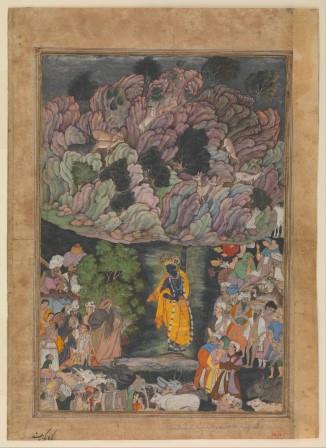 Krishna holds mount Govardhan (Image Credits: Met Museum)
Krishna holds mount Govardhan (Image Credits: Met Museum)
Theme: Krishna Painting
Title: Krishna Holds Up Mount Govardhan to Shelter the Villagers of Braj, Folio from Harivamsa (The Legend of Hari (Krishna))
Date Created: 1590-95
Place: Made in present-day Pakistan, probably Lahore
Physical Dimensions: 11.37 inches x 7.87 inches (28.9 cm x 20 cm)
Medium: On paper, Ink, opaque watercolor, and gold
Vasudeva carries the Infant Krishna across the Yamuna River
The Krishna painting is charmingly simple and the picture illustrates the scene from the Bhagavata Purana that occurs immediately after Krishna's birth. In Bhagavat Purana, the legend has it that, a prophecy from the sky, that Kamsa, king of Mathura would be killed by his nephew, the eighth son born to his sister Devaki when she got married to Vasudeva. Kamsa wanted to kill his sister right then but was persuaded by Vasudeva, who promised he will deliver each son born to them to Kamsa. Kamsa agreed but imprisoned the newly married couple. One by one each child born to the couple was handed over to Kamsa, who promptly killed them. The eighth child born to the couple was Krishna, who came into their dreams and told them, when he (Krishna) will be born, to take him across the Yamuna river and exchange him for the daughter of Yashodha and Nanda.
The Krishna painting depicts the newborn baby Krishna as he is taken to safety by his father Vasudeva in stormy weather. The skies are stormy and it is raining heavily. The torrential rains are depicted like a string of pearls, carefully delineating the shelters underneath the tree on the left and underneath the hood of Sheshnaga. In dark colors, the swirling whirlpools and eddies in the Yamuna river are beautifully depicted. Vasudeva is not deterred by the stormy weather, as wades into the violent swollen Yamuna river with hundreds of whirlpools and eddies. Following him is the king of Serpents, Sheshnag,(one of Vishnu's mounts) who spread his hood to protect the infant baby Krishna from the rain, like an umbrella.
The Krishna painting follows the text of Bhagavat Purana, closely with clouds and lightning in the sky, many hooded Sheshnag, and hundreds of whirlpools in the river. But the magnificent tiger is a surprise for the viewer. He may be a symbol of the many dangers of that surround infant Krishna and his father Vasudeva. A large flat monochrome surface and crisply drawn figures show the artist's boldness in the use of color and his passion for his art shines through in the painting. In the rendering of the painting, a deep understanding, feeling, and respect can be seen alongside its simplicity.
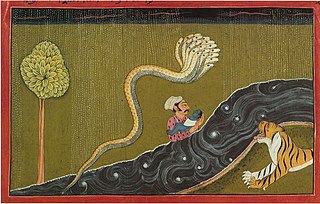 Vasudev takes Krishna across Yamuna (Image Credits: Wikicommons.com)
Vasudev takes Krishna across Yamuna (Image Credits: Wikicommons.com)
Theme: Krishna Painting
Title: Vasudeva carries the Infant Krishna across the Yamuna River, Folio from Bhagavata Purana
Date Created: 1700-1720
Place: Mankot, Uttarakhand
Physical Dimensions: 6.88 inches x 11.06 inches (17.5 cm x 28.1 cm)
Medium: On paper, opaque watercolor
In the Contemporary Period
Krishna continues to be relevant and popular with people as he was thousands of years back. Artists are still inspired by him and continue to make Krishna paintings. Below are a few of the contemporary portrayals of Krisha. The paintings are handmade oil painting reproductions made for clients and patrons upon their requests.
Yashoda ma and Krishna
Tales of baby Krishna, Yashoda ma, and butter are many. You see dear reader, Baby Krishna was inordinately fond of homemade butter.
In the Krishna painting, the artist depicts a scene between Yashoda ma, and baby Krishna, while she is churning the butter. Blue-skinned baby Krishna is leaning on Yashoda ma while she is churning the milk to make butter in the pot. Butter is falling on the floor and the other pots are filled with it. Baby Krishna is depicted wearing his peacock crown, with lumps of butter in both of his hands with an expression of a mischievous and happy smile on his face. Yashoda ma is looking at Krishna with a bemused smile and her face beaming with love for Krishna, as only a mother can have for her child. She is wearing a resplendent saree and jewelry. The intricate design of the jewelry embedded with precious stones and the patterns on the saree make them stand out. Her hands are holding the ropes to churn the butter and suggest motion in the painting. The setting of the room is large and spacious. The pillars of the room are ornamented with decorative patterns on them. And in the background, the dark and rich-quality curtains could be seen hanging. At the bottom of the painting a small cow can be seen, perhaps a symbolic expression of Krishna's love for cows. The Krishna painting has been done in the classical academic realism style.
The painting brilliantly captures the love between Yashoda ma and Krishna. The bright shade of Yashoda ma's saree stands out against the blue of Krisha's skin. The colors of jewelry embedded with precious stones also shine brightly. The traditional designs of the room and accessories add to the beauty of the painting. The artist has used a mix of warm and cool colors to create a sense of depth and bring out the emotion between the characters. This painting is a beautiful representation of the bond between mother and child and speaks to the love and devotion that Yashoda ma had for her son. The Krishna painting is a testament that even in difficult times, unconditional love can prevail.
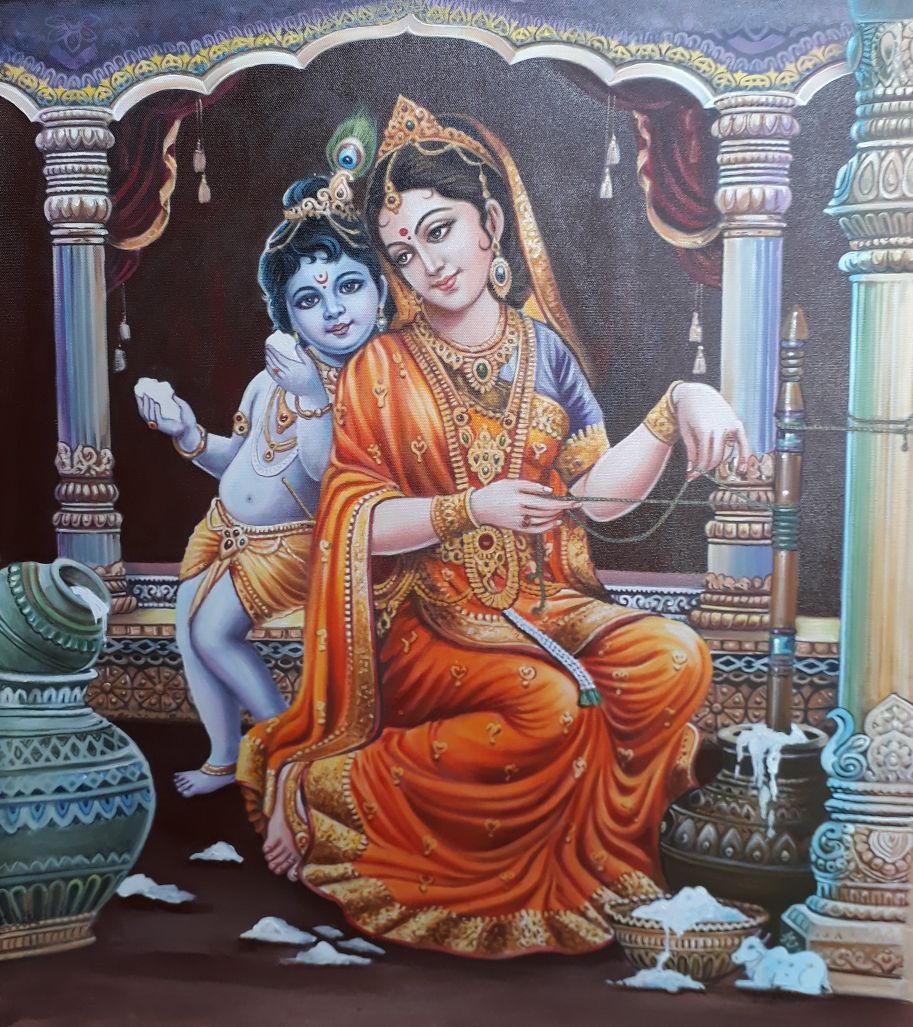 Baal Krishna and Yashoda Ma (Image credits: Paintphotograpphs.com)
Baal Krishna and Yashoda Ma (Image credits: Paintphotograpphs.com)
Theme: Krishna Painting
Title: Yashoda ma and Krishna
Date Created: 2018
Physical Dimensions: 36 inches x 24 inches (91.44 cm x 60.96 cm)
Medium: Oil painting reproduction on canvas
Location: Private collection
Shri Krishna Vishwaroop revealed to Arjuna
In Mahabharat, at the start of the battle between the Pandavas and the Kauravas at Kurukshetra, Arjuna lost his will to fight, seeing the vast army of his family and cousins arrayed against each. He realized whoever wins the war, death, and sorrow will engulf the family and the world. He turned to his friend and charioteer Shri Krishna for advice. The Hindu philosophical treatise the Gita records the discourse that followed. In the Gita, Shri Krisha reveals his Visharoop, Divine form, to Arjun in chapter 11 in a series of dialog that follows:
Chapter 11-03
Arjun:
evam etad yathāttha tvam ātmānaṁ parameśhvara
draṣhṭum ichchhāmi te rūpam aiśhwaraṁ puruṣhottama
O Supreme Lord, You are precisely what You declare yourself to be. Now I desire to see Your divine cosmic form, O Greatest of persons.
11-04
Arjun:
manyase yadi tach chhakyaṁ mayā draṣhṭum iti prabho
yogeśhvara tato me tvaṁ darśhayātmānam avyayam
O Lord of all mystic powers, if You think I am strong enough to behold It, then kindly reveal that imperishable cosmic form to me.
11-05
Lord Vishnu:
śhrī-bhagavān uvācha
paśhya me pārtha rūpāṇi śhataśho 'tha sahasraśhaḥ
nānā-vidhāni divyāni nānā-varṇākṛitīni cha
The Supreme Lord said: Behold, O Parth, My hundreds and thousands of wonderful forms of various shapes, sizes, and colors.
11-06
Lord Vishnu:
paśhyādityān vasūn rudrān aśhvinau marutas tathā
bahūny adṛiṣhṭa-pūrvāṇi paśhyāśhcharyāṇi bhārata
Behold in Me, O scion of the Bharatas, the (twelve) sons of Aditi, the (eight) vasus, the (eleven) rudras, the (twin) Ashwini Kumars, as well as the (forty-nine) Maruts, and many more marvels never revealed before.
11-07
Lord Vishnu:
ihaika-sthaṁ jagat kṛitsnaṁ paśhyādya sa-charācharam
mama dehe guḍākeśha yach chānyad draṣhṭum ichchhasi
Behold now, Arjun, the entire universe, with everything moving and non-moving, assembled in My universal form. Whatever else you wish to see, observe it all within this universal form.
11-08
na tu māṁ śhakyase draṣhṭum anenaiva sva-chakṣhuṣhā
divyaṁ dadāmi te chakṣhuḥ paśhya me yogam aiśhwaram
But you cannot see My cosmic form with these physical eyes of yours. Therefore, I grant you divine vision. Behold My majestic opulence!
11-09
Sanjay Said:
sañjaya uvācha
evam uktvā tato rājan mahā-yogeśhvaro hariḥ
darśhayām āsa pārthāya paramaṁ rūpam aiśhwaram
Sanjay said: O King, having spoken thus, the Supreme Lord of Yog, Shri Krishna, displayed his divine and opulent form to Arjun.
The painting Shri Krishna Vishwaroop revealed to Arjuna depicts that momentous scene when Shri Krishna revealed his divine form to Arjuna. In the painting, Arjun can be seen fully in battle regalia, sitting at the feet of Shri Krishna, looking up at him with folded hands, as a supplicant. The look of reverence and devotion in Arjuna's eyes as he looks up at Krishna is captured to near perfection in the painting.
Shri Krishna can be seen standing before Arjuna, with vanmala (garland) on his neck with a calm and serene expression on his face, his right hand touching his chest as though explaining himself to Arjuna. The way Shri Krishna is portrayed with a calm, serene expression emphasizes his divinity and wisdom.
Shri Vishnu, with his eyes half closed and a calm stoic expression on his face is shown towering over Krishna and Arjun to symbolize the true nature of his Godhood. Shri Vishnu, depicted in blue color, is the creator, and protector of the Universe. He is shown with his four arms carrying a Shanka (conch), Gada (mace), the Sudarshan chakra, and the Lotus. The four arms symbolize the fulfillment of manifestations in all spheres of life. The Shankha (conch) symbolizes the creation of and cyclical nature of life, the Gada, (mace) symbolizes the power of authority and knowledge, the Sudharshan chakra symbolizes the divine weapon to maintain Dharma in the Universe and the Lotus is the symbol of purity, spiritual wealth, abundance, growth, and fertility. Around Vishnu, many formless heads can be seen symbolizing all life, all creation, and the Universe itself originating from Vishnu.
The Krishna painting is dramatic in its presentation and captures a timeless moment between two of the most important characters in Hindu mythology. The scale and the composition of the painting convey both a sense of majesty and reverence and will inspire awe in viewers.
 Krishna reveals his Vishwaroop to Arjun (Image Credits: Paintphotographs.com)
Krishna reveals his Vishwaroop to Arjun (Image Credits: Paintphotographs.com)
Theme: Krishna Painting
Title: Shri Krishna Vishwaroop revealed to Arjuna
Date Created: 2022
Physical Dimensions: 36 inches x 30 inches (91.44 cm x 76.2 cm)
Medium: Oil painting reproduction on canvas
Location: Private Collection
Radha Krish Playing Flute
The painting Radha Krishna playing flute depicts a romantic moment as Krishna teaches Radha to play the flute. The image is a close-up of the faces of Radha and Krishna. Krishna stands behind Radha, holding up his flute for Radha to blow into. The expression on Krishna's face is of the sublime joy of a lover, with his eyes closed enjoying the divine nature of love. Radha is seen pursing her lips as if about to blow into the flute, her eyes shining with joy and love. Peacock feathers are shown strewn over their faces, a symbol of Krishna, as a butterfly flies away. Both the pair of faces are glowing from excitement and love.
The painting of the couple evokes a sense of timelessness, and it can be interpreted as a metaphor for the journey of spiritual and romantic love. The flute is an important instrument in Krishna mythology, symbolizing the link between divine and human love. The peacock feathers represent Krishna's divine energy, while the butterfly flying away speaks to the fleetingness of time. The overall composition gives a feeling of blissful eternity. The viewer is left with the impression that an intimate moment has been shared between two lovers.
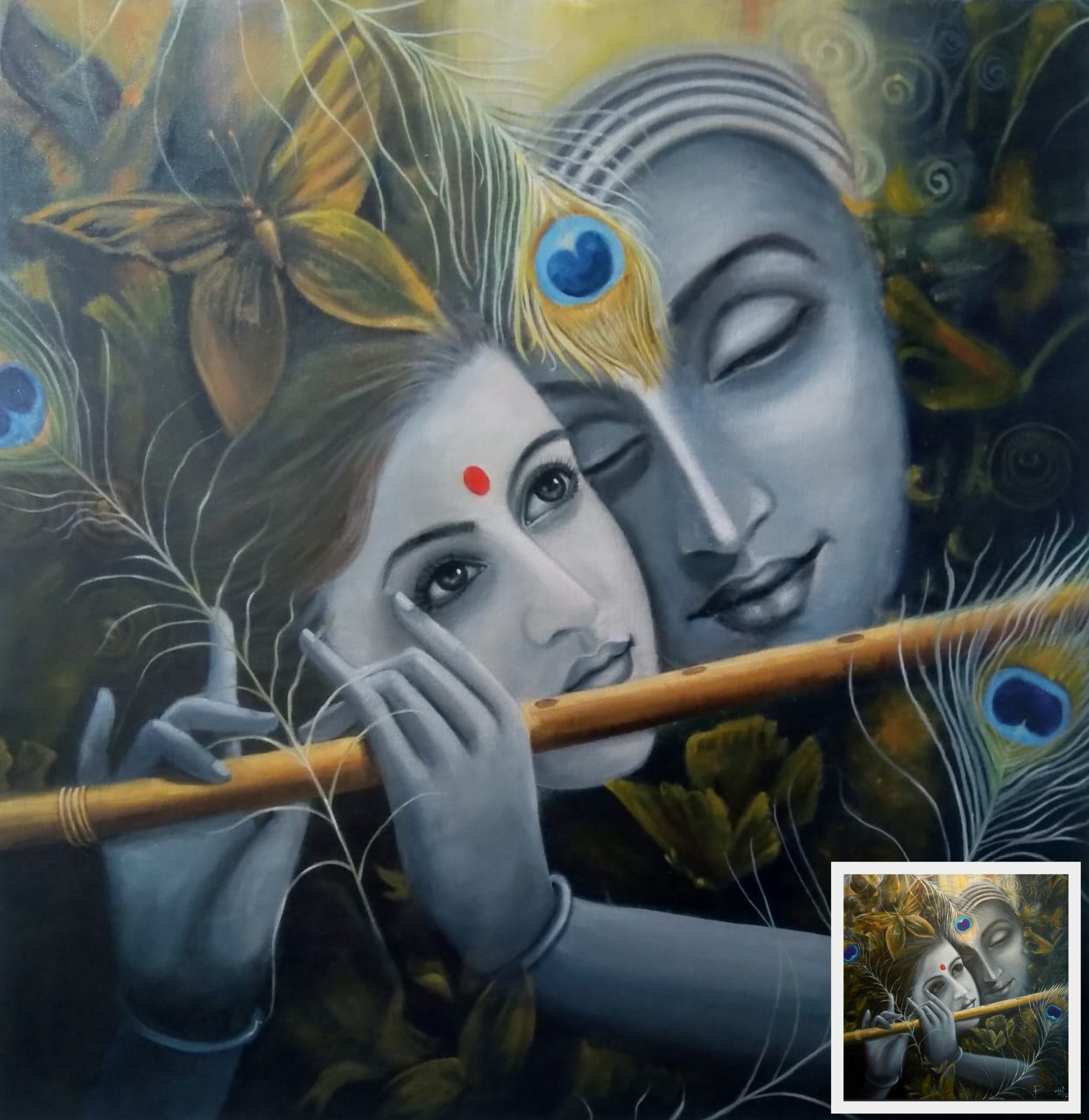 Radha Krishna Playing Flute (Image Credits: Paintphotographs.com)
Radha Krishna Playing Flute (Image Credits: Paintphotographs.com)
Theme: Krishna Painting
Title: Radha Krish Playing Flute
Date Created: 2020
Physical Dimensions: 24 inches x 24 inches (60.96 cm x 60.96 cm)
Medium: Oil painting reproduction on canvas
Location: Private Collection
Krishana Reimagined
Krishna Reimagined is a modern reinterpretation of Krisha. The painting depicts Krishna in the traditional blue color, as the Lord of the Universe with thousands of planets around him orbiting in the universe. Energy symbolized in shades of bright yellow and red, is seen pouring out of his hair symbolizing he is the creator and sustainer of the Universe. He depicted playing his flute, the divine tune that keeps the universe in harmony and balance. At his feet is shown a human form sitting in meditation in a yogic posture. Below the human form is a white lotus flower, symbolizing purity and spiritual growth. The painting is a beautiful reminder of the importance of staying connected to our spiritual path and understanding the power of balance in life. It encourages us to take time for meditation and to find harmony in every aspect of our lives. The painting also reminds us to stay humble and recognize that we are all part of a greater cosmic order, while also understanding that we can still make a difference. By embracing the spirit of Krishna, we are empowered to strive for greatness and discover our inner strength. The painting is a dramatic, visual, impactful, and modern reinterpretation of the story of Krishna.
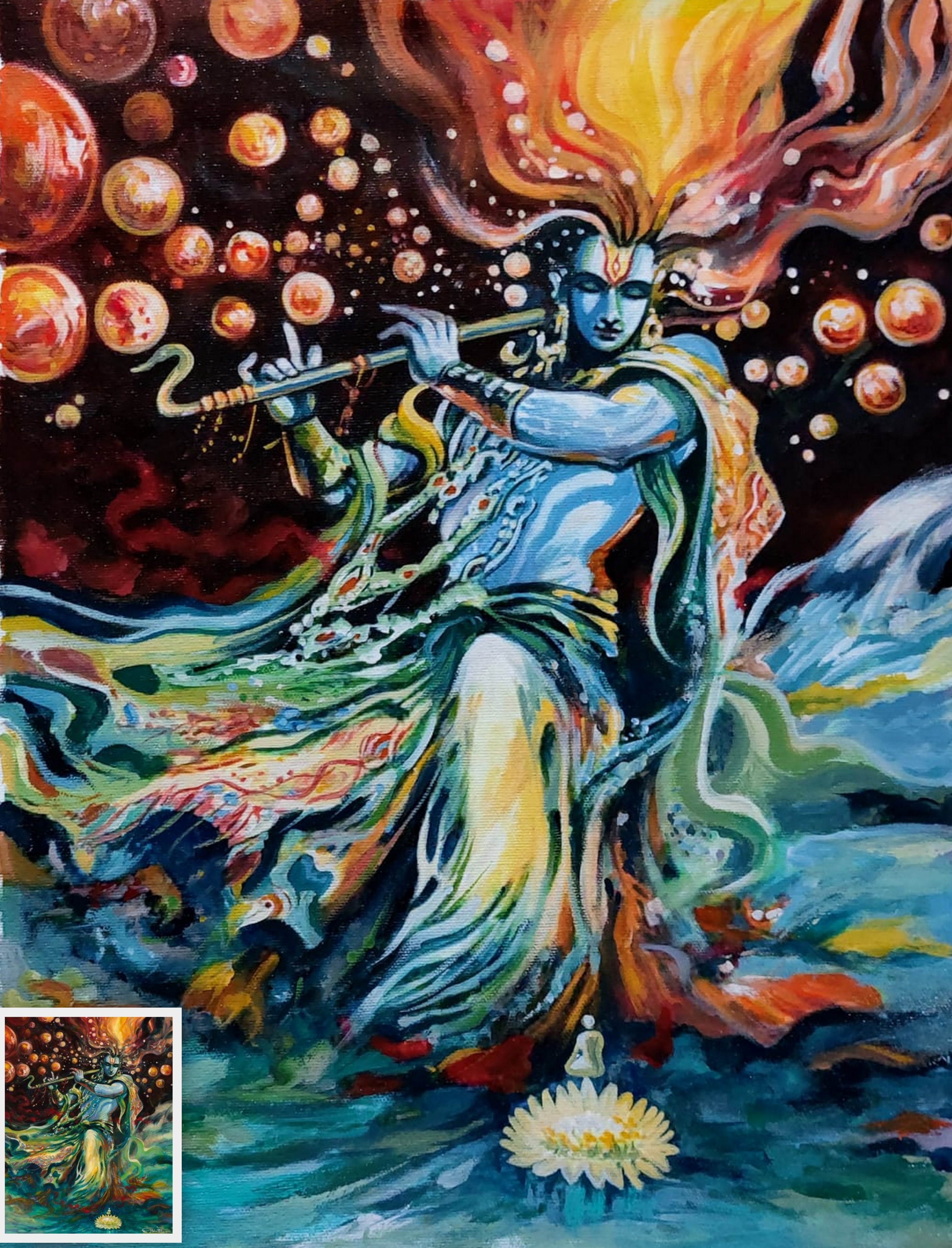 Krishna Re-Imagined (Image Credits: Paintphotographs.com)
Krishna Re-Imagined (Image Credits: Paintphotographs.com)
Theme: Krishna Painting
Title: Krishana Reimagined
Date Created: 2022
Physical Dimensions: 20 inches x 16 inches (50.8 cm x 40.64 cm)
Medium: Oil painting reproduction on canvas
Location: Private Collection
Modern Art Radha Krishna Painting
The painting is a modern reinterpretation of Radha Krishna's love story. The modern art Radha Krishna painting reinterprets the Radha Krishna romance using modern art concepts pioneered in India by artists like KCS Paniker In the painting, both Radha and Krishna are shown playing the flute. Symbolic of the equality of men and women. Krishna in blue color is depicted sitting crossed-legged on the ground and behind him stands Radha. Both are seen playing flutes as though they are in musical jugalbandi (jamming). The abstract patchwork shades of green have been used extensively to suggest a forest backdrop. The use of angular shapes and lines also gives the painting a modern and abstract feel, making it a refreshing take on the traditional Radha Krishna story.
The painting conveys the message of divine love between Radha and Krishna. The use of bright colors adds a vibrant feel to the painting, creating a sense of joy and harmony. The use of thick lines and abstract elements to depict the forest backdrop symbolizes the complexity of their relationship. The two figures in perfect harmony with each other, despite the complexity, represent how true love can transcend all boundaries.
The painting is a beautiful blend of modern art concepts and traditional themes, creating a truly unique and captivating piece of art. Overall, the modern art Radha Krishna painting is a beautiful and thought-provoking reinterpretation of the classic love story. It showcases the artist's skill and creativity and is sure to be appreciated by art lovers and fans of the Radha Krishna story alike.
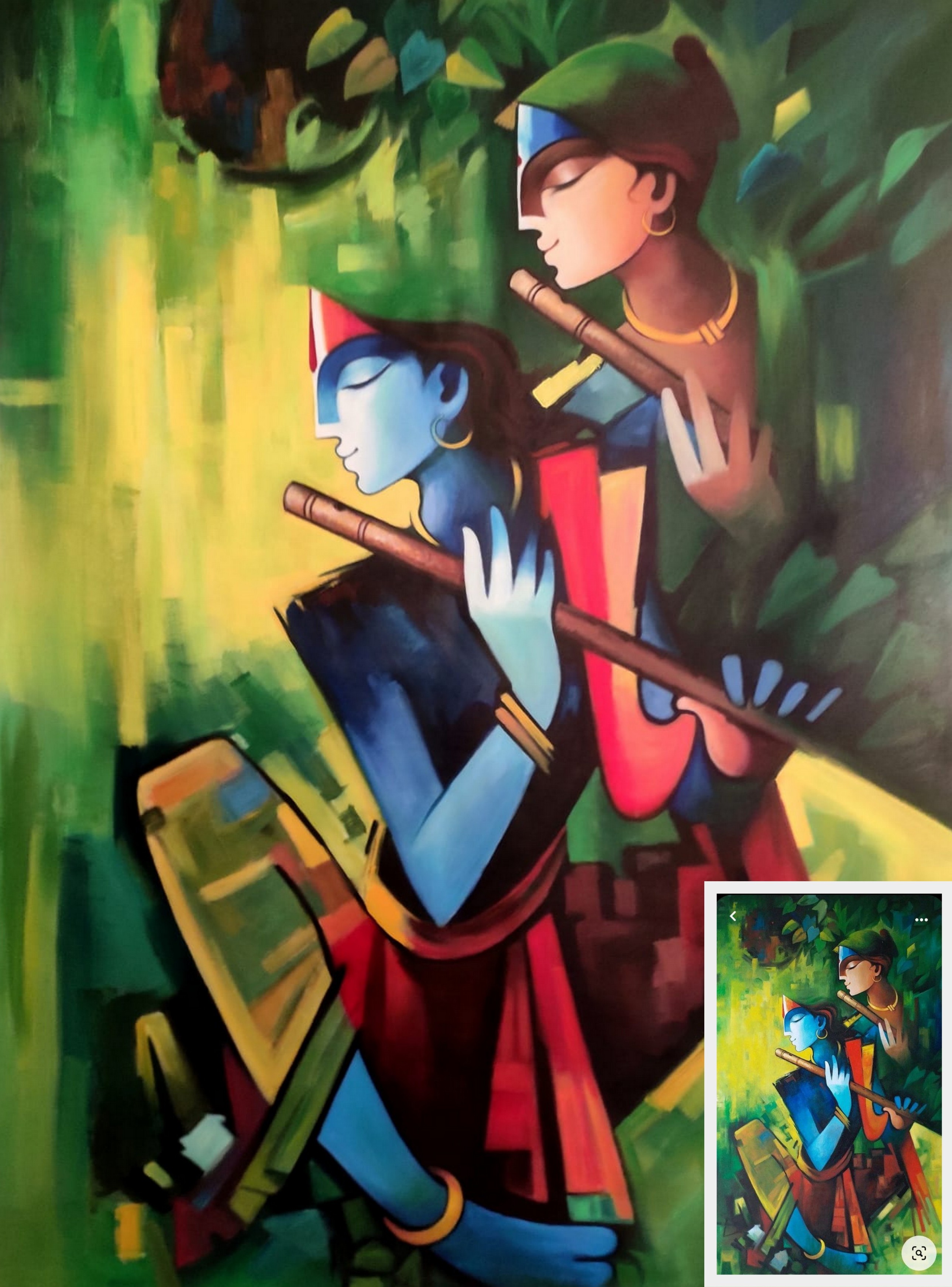 Modern art Radha Krishna Painting (Image Credits: Paintphotographs.com)
Modern art Radha Krishna Painting (Image Credits: Paintphotographs.com)
Theme: Krishna Painting
Title: Modern art Radha Krishna
Date Created: 2022
Physical Dimensions: 66 inches x 46 inches (167.4 cm x 116.84 cm)
Medium: Oil painting reproduction on canvas
Little Krishna
While all the previous examples are works of art inspired by the many stories from the life of Krishna, interpretations of artists' thoughts on Krishna, they don't reflect the love and affection that ordinary people have for Krisha.
In the portrait painting below, a baby is depicted as Krishna. The portrait of the child was made from a photo of him as he was standing looking upwards. He was dressed up as little Krishna, possibly to celebrate Janmashtami, the birthday of Krishna celebrated across India. We changed the backdrop of the photo in the painting, to give it a more exotic cosmic feel.
The colors used in the painting are vibrant and include shades of blue, green, and yellow. These colors come together to create a mesmerizing effect that captures the essence of little Krishna.
The painting paints a picture of innocence and joy. The baby's face radiates through the painting and the divine nature of Krishna is felt in it. The yellow, orange and blue colors of the painting capture the vibrant nature of Janmashtami and Krishna's many divine qualities. The portrait offers a calming and peaceful feeling to viewers. It is an ode to the beauty of innocence, as well as a reminder of the divine grace of Krishna.
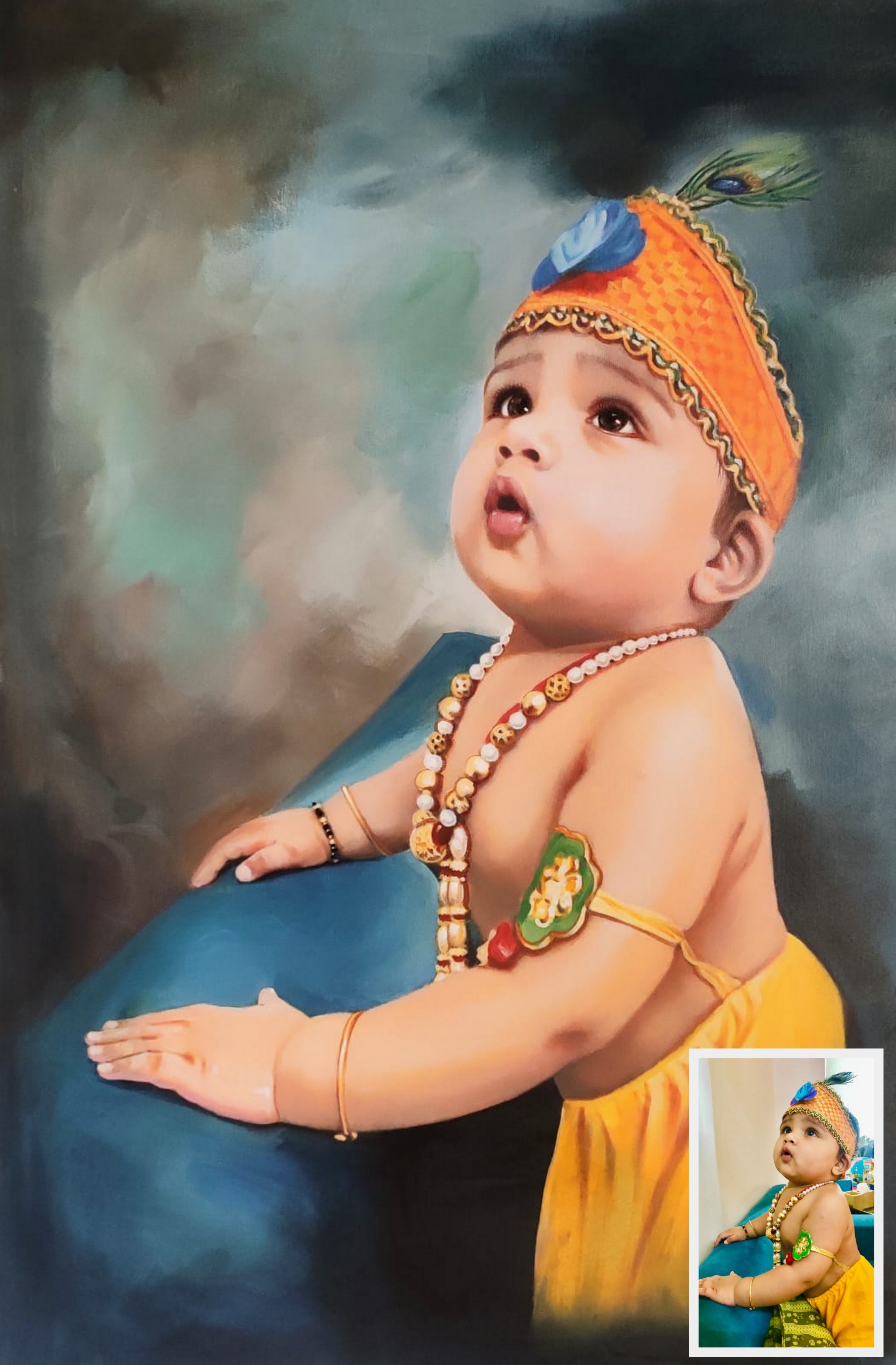 Baby dressed as Krishna, Oil portrait painting (Image Credits: Paintphotographs.com)
Baby dressed as Krishna, Oil portrait painting (Image Credits: Paintphotographs.com)
Theme: Krishna Painting
Title: Little Krishna
Date Created: 2020
Physical Dimensions: 36 inches x 24 inches (91.44 cm x 60.96 cm)
Medium: Oil portrait painting on canvas
Location: Private Collection
Conclusion:
These Krishna paintings and artworks have a deep spiritual meaning and often portray the divine character of Lord Krishna. They serve as a reminder of his teachings and can be found in various forms, from traditional paintings and sculptures to modern artworks. Many contemporary artists have created paintings of Krishna, often adapting traditional iconography to modern art contexts.
Krishna's influence is seen widely in many aspects of Indian culture today. From art and music to dance, Krishna's presence can be felt in every aspect of society. Krishna paintings are often used to adorn temples and homes around the country, showing the reverence with which he is held. He is also seen as a symbol of strength and unity, with many believing that he can bring people together during trouble. His message of compassion and understanding still rings true today, making him a revered figure in India and beyond.
About Us:
Paintphotographs.com is India's leading custom art platform. We turn your favorite photos, pics, and images into luxurious handmade portrait paintings. Our work includes handmade portraits, custom oil reproductions, charcoal drawings, and sketches. As a team of accomplished artists, we use museum-quality canvas, the best international brands of colors such as Winsor & Newton and Daler Rawney. We work with various mediums, including oil, acrylic, mixed media, graphite, and charcoal.
To order a custom handmade oil portrait painting you can visit our order now page. You can order custom Wedding Paintings, Couple Paintings, Memorial Paintings, Family Paintings, Baby portraits and Children Paintings, Photo to paintings, and Pet Portrait Paintings from Photo.
You can visit our pricing page to know the prices of our portrait paintings. To connect with us ping us on our chat messenger on the website, ping us on WhatsApp, call us at 918291070650, or drop us an email at support@paintphotographs.com
You can visit our gallery pages to see our work. We make photo to paintings, couple paintings, memorial paintings, Kids and Baby Portrait paintings, God & Religious Paintings, Old Photo to Paintings, Wedding couple Paintings & Marriage Portraits, Family Paintings, Pet Portrait Paintings, Radha Krishna Paintings, Oil Portraits of Gurus, Saints & Holy Men, Charcoal and Pencil Sketches, Custom Landscape & Cityscape paintings, Contemporary Art Reproduction & Replica Paintings, Old Master Reproduction & Replica Art, Monochrome and Black & White portrait paintings, Historical Portraits and Shivaji Maharaj Paintings, Celebrity & Political Leaders Portraits. We can also merge separate photos to create a single seamless painting called Composite portraits to add deceased loved ones to make a family oil portrait as though they were present.
Our custom handmade portraits make beautiful Anniversary Gifts, Engagement Gifts, Birthday Gifts, Retirement Gifts, Housewarming Gifts, Mother's Day gifts, and luxurious gifts for many important occasions.
Paintphotographs.com provides bespoke services for art patrons, interior designers, and architects. It helps you create the perfect pieces for residential and commercial projects and serves as a platform for artists to showcase their work.
If you are an art aficionado interested in writing a guest post on art, connect with us.
Want to read more? Check our reading recommendations below! Please refer to the Notes and Reference section for sources referenced in the article.
Like this story? Then you will love our podcasts on Spotify. Listen to our deep dives and fascinating stories from the art world. Join our nearly 20,000-strong community on Facebook, WhatsApp, and X.
Want to see our art? Join our community of 500,000+ subscribers on the Paintphotographs YouTube channel, Instagram, and Pinterest for some amazing art pics & art videos!
Check Our Recommended Categories
Recommended Reads:
Making Oil Portrait Paintings and Learning about Spiritual Gurus of India | Paintphotographs
The life and paintings of artist and painter KCS Paniker | Paintphotographs
Ultimate 20 Best Oil Portrait Paintings of John Singer Sargent (Ranked) | Paintphotographs
What are the different types of portrait painting? | Paintphotographs
References and Notes:
(PDF) Vrishnis in Ancient Literature and Art | Vinay Kumar Gupta - Academia.edu
(PDF) Art Passages Krishna: The Divine Dalliance | Robert J Del Bonta - Academia.edu
Vasudeva carries the Infant Krishna across the Yamuna River, India | Mia
Chapter 11: Viśhwarūp Darśhan Yog – Bhagavad Gita, The Song of God – Swami Mukundananda
https://www.google.co.in/books/edition/The_Spirit_of_Indian_Painting/1-rfrQEACAAJ?hl=en

